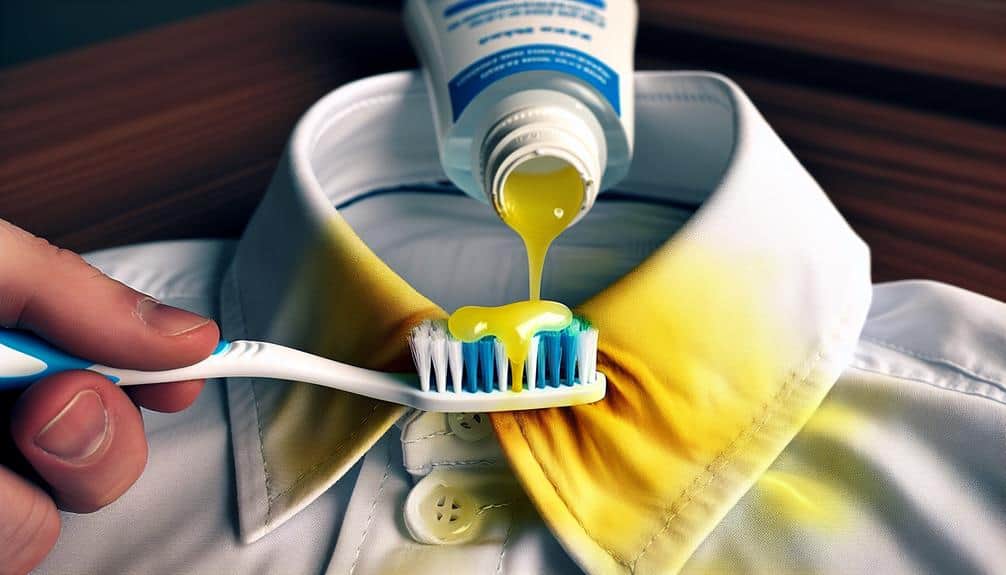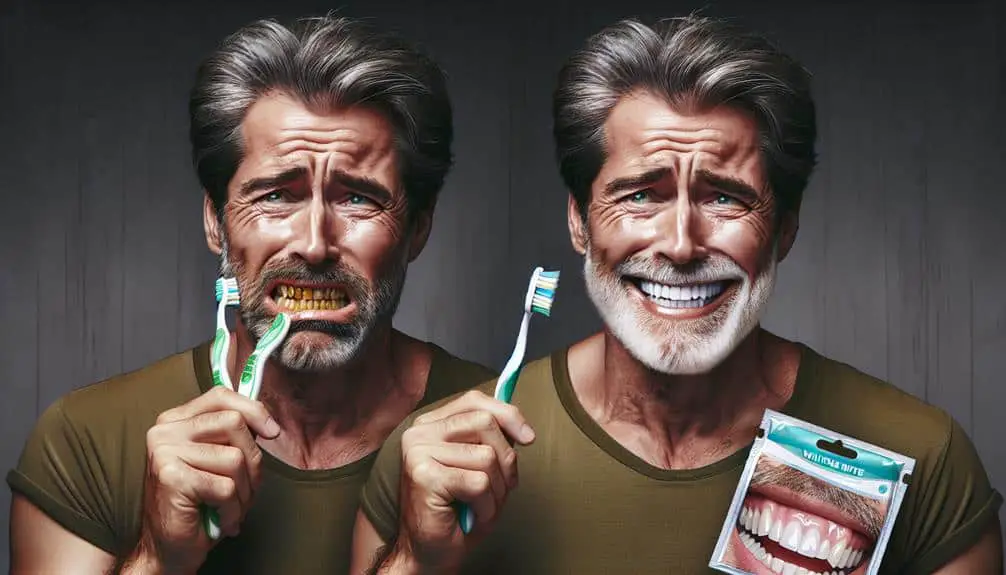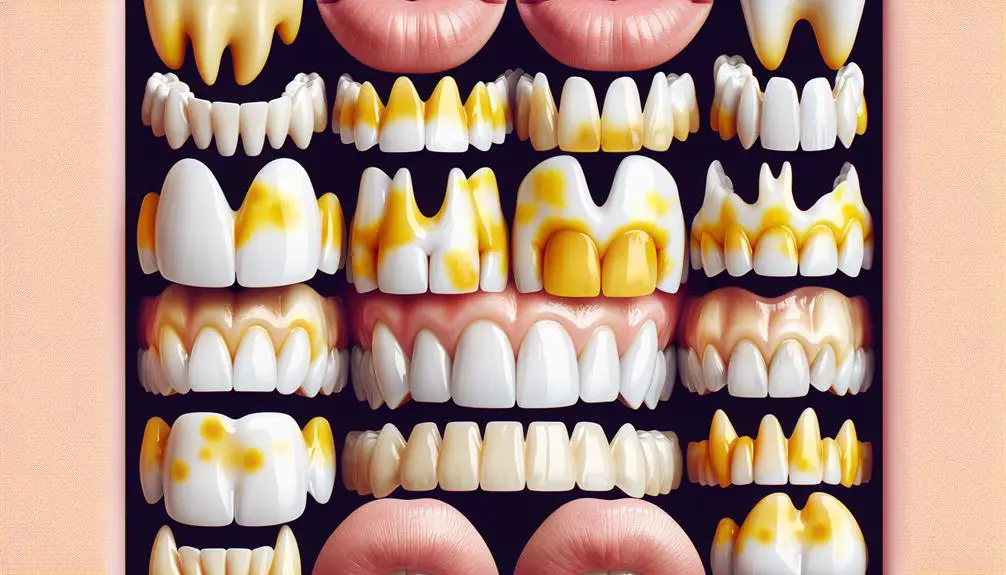To eliminate whitening medication stains, start by selecting the appropriate products based on your stains and dental history. Look for hydrogen peroxide or carbamide peroxide. Assess your oral health and address any issues before whitening. Follow instructions and avoid gum contact when applying treatment. Maintain oral hygiene and avoid staining foods. Address sensitivity by using desensitizing toothpaste and gentle brushing. It's essential to take a step-by-step approach to effectively tackle these stains.
Key Points
- Choose whitening products suitable for medication stains
- Research ingredients to ensure effectiveness
- Consider dental history and sensitivity
- Apply whitening treatment following instructions carefully
- Maintain oral hygiene to prolong whitening results
Choosing the Right Whitening Products
When selecting whitening products, make sure they're specifically formulated for your type of stains and dental history. Product selection plays a vital role in achieving effective results. Conduct thorough ingredient research to guarantee the product aligns with your needs. Look for products containing active ingredients like hydrogen peroxide or carbamide peroxide, as these are proven to be effective in whitening teeth.
Consider your dental history when choosing a whitening product. If you have sensitive teeth or existing dental restorations, such as crowns or veneers, opt for products that are gentle on these areas to avoid potential damage. Additionally, if you have specific types of stains, such as those caused by medications, look for products designed to target and remove these particular stains.
Preparing Your Teeth for Whitening
To prepare your teeth for whitening effectively, evaluate your current oral health status and address any existing dental concerns before starting the whitening process. This initial step guarantees that your teeth are in peak condition to achieve the best possible results from the whitening treatment. Here are some key aspects to contemplate:
- Flossing Technique: Proper flossing is crucial to eliminate plaque and food particles from between your teeth, ensuring a clean surface for the whitening agent to work effectively. Make sure to floss gently yet thoroughly to avoid harming your gums and teeth.
- Diet Choices: Your diet plays a significant role in maintaining oral health. Avoiding foods and beverages that can stain your teeth, such as coffee, tea, and red wine, can help prolong the effects of whitening treatments. Opt for a balanced diet rich in fruits and vegetables to promote overall dental health.
- Regular Dental Check-ups: Before beginning any whitening regimen, schedule a dental check-up to address any underlying issues like cavities or gum disease. A professional cleaning can also help remove surface stains, enhancing the whitening process.
Applying Whitening Treatment Correctly
For optimal outcomes, make sure that you follow the correct procedure when applying whitening treatment to your teeth. Proper application is key to achieving consistent results. Start by carefully reading and following the instructions provided with the whitening product you have selected.
Commence by brushing your teeth with a fluoride toothpaste to eliminate any surface stains and guarantee that your teeth are clean. Next, apply a small amount of the whitening gel or strips to the front surface of your teeth as directed. Make sure to avoid getting the whitening product on your gums to prevent irritation.
After applying the whitening treatment, follow the recommended time for leaving it on your teeth. This duration can vary depending on the product you're using. It's essential not to exceed the recommended time to prevent damage to your teeth or sensitivity.
Consistency in applying the whitening treatment is vital for achieving the desired results. Adhere to the recommended frequency of use, whether it's daily or weekly, to observe a noticeable improvement in the whiteness of your teeth.
Maintaining Whitened Teeth
Consistent oral hygiene practices, including regular brushing and flossing, play an essential role in maintaining the whiteness of your teeth after whitening treatment. To safeguard that your teeth stay bright and healthy, consider the following:
- Diet Choices: Opt for teeth-friendly foods like crunchy fruits and vegetables that can help clean your teeth naturally. Avoid excessive consumption of staining agents like coffee, tea, and red wine, as they can compromise the whiteness of your teeth.
- Regular Checkups: Schedule routine dental checkups to monitor the health of your teeth and address any issues promptly. Professional cleanings can help remove surface stains and prevent discoloration, contributing to the longevity of your whitened smile.
- Hydration: Drink plenty of water throughout the day to keep your mouth moist and help wash away food particles that can lead to staining. Staying hydrated also promotes saliva production, which is essential for maintaining oral health and reducing the risk of discoloration.
Dealing With Sensitivity Issues
Maintaining the whiteness of your teeth also involves addressing any sensitivity issues that may arise post-whitening treatment. Sensitivity management is vital in ensuring your comfort and overall oral health. If you experience tooth sensitivity after whitening, there are steps you can take to alleviate the discomfort and prevent pain.
One effective method is to use toothpaste designed for sensitive teeth, which can help desensitize the nerves in your teeth. These toothpastes typically contain ingredients like potassium nitrate or strontium chloride, known for their ability to reduce sensitivity.
Another pain prevention technique is to avoid consuming extremely hot or cold foods and beverages, as extreme temperatures can exacerbate sensitivity. Additionally, using a soft-bristled toothbrush and gentle brushing techniques can help prevent further irritation to sensitive teeth.
If sensitivity persists or worsens, consulting your dentist is recommended to rule out any underlying issues and explore potential treatment options tailored to your specific needs. Remember, managing sensitivity is an important aspect of maintaining your bright smile post-whitening.
Frequently Asked Questions
Can Whitening Medication Stains Be Effectively Removed With At-Home Whitening Products, or Is Professional Treatment Necessary?
You can often remove whitening medication stains at home with over-the-counter products. However, for stubborn stains or faster results, professional treatment might be necessary. Natural options can work, but chemical products typically offer quicker results.
Are There Any Specific Dietary Restrictions or Habits to Avoid in Order to Prevent Further Staining After Whitening Medication Stains Have Been Removed?
To prevent further staining after removing whitening medication stains, consider dietary restrictions like minimizing dark-colored foods and beverages. Avoid habits like smoking, as they can lead to discoloration. Maintaining good oral hygiene is essential for long-lasting results.
How Long Does It Typically Take to See Noticeable Results When Using Whitening Products to Treat Medication Stains on Teeth?
Typically, noticeable results from whitening products for medication stains on teeth can be seen within a few weeks. The progress timeline varies based on individual factors, but treatment effectiveness is usually evident after consistent use over the recommended period.
Are There Any Alternative Treatments or Procedures That Can Be Used in Conjunction With Whitening Products to Enhance the Results for Medication Stains?
To enhance results for medication stains, consider alternative treatments like bonding or veneers, in combination with whitening products. These combination therapies can maximize results by addressing underlying discoloration and providing a long-lasting solution for a brighter smile.
Are There Any Potential Risks or Side Effects Associated With Using Whitening Products to Treat Medication Stains, and How Can They Be Minimized or Avoided?
You'll be pleased to know that while whitening products can have potential risks and side effects like tooth sensitivity, proper usage and following instructions diligently can minimize or even avoid these issues, ensuring a brighter smile safely.



